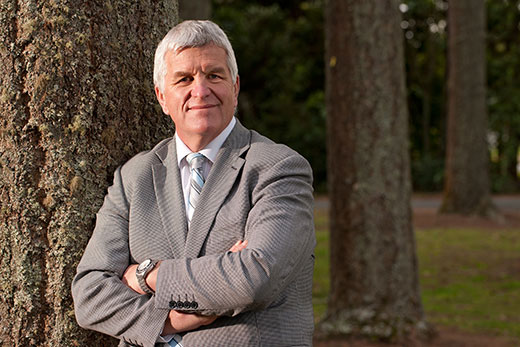By 2100, when his oldest granddaughter is 98, the world is predicted, in some scenarios, to be four to five degrees hotter, and that’s worrying Scion’s CEO, Dr Warren Parker.

Dr Warren Parker, CEO of Scion, is worried about the world his grandchildren will inherit.
Economic value
Warren told the audience at the 2015 Bay of Plenty Ballance Farm Environment Awards that Scion’s purpose is to drive innovation and growth in the forestry and wood sectors to ‘build economic value and contribute to beneficial environmental and social outcomes for New Zealand’.
“The world will need more food to feed its future population of 9.5 billion but it will also need 500 to 600 per cent more wood and wood fibre for housing, clothing, and for new materials replacing plastics.”
Statistics indicate deforestation of an estimated 10,000 hectares of land occurred last year.
The ongoing felling of trees will have an impact on the long-term supply of wood, especially for big consumers like China and the USA.
Radiata pines
“By 2020 there will be a world shortage of long fibre softwoods produced by radiata pines grown in New Zealand.”
Those long fibres are important because they are strong, and products made from them are now being used in car manufacture in Europe.
“The product is light, can be coloured, is just as strong as plastics, and it can be produced by radiata pines growing here in the Bay of Plenty.”
Warren says trees can also produce biofuels to power cars, and are used as a source of food for livestock.

Scion is at the forefront of bioplastics technologies using renewable resources like wood and crop residues to create new products such as these containers.
TV screens
Even today wood fibres are used in unexpected ways, including the manufacture of television screens.
Research into more uses for timber, plus which trees produce the best products and how to grow them, is ongoing.
Technology such as drones to photograph and map forests and hand-held devices to measure the dimensions of a tree and the quality of its timber, are already in use.
Scion is also researching growing native totara and kauri trees commercially. “Totara can be harvested for commercial purposes in 40 years and kauri in 60 years.” Kauri dieback disease is also the focus of research to find ways to give trees the resilience they need to survive it.
Warren, who was guest speaker at the 2015 Bay of Plenty Ballance Farm Environment Awards, describes the entrants as leaders in their farming and horticultural industries.
“You are exemplars for your industries and can positively influence others. It’s been said you can’t be green if you are in the red [financially] but in the future it may be difficult to be in the black unless you are green.”



0 Comments
Leave a Comment